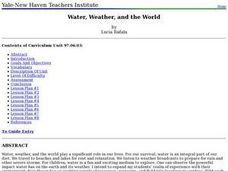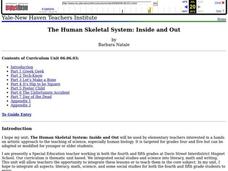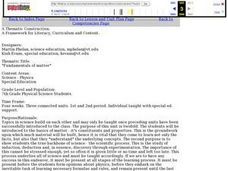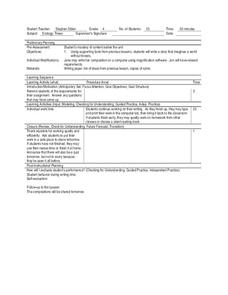American Chemical Society
Isolation of Phytochrome
Why do soybean plants that are planted weeks apart in the spring mature simultaneously in the fall? Four independent activities cover the history of phytochrome research, scientist collaboration, the electromagnetic spectrum, and...
American Chemical Society
Joseph Priestley, Discoverer of Oxygen
Do you want to hear a joke about nitrogen and oxygen? NO. We all know there is oxygen in the air and that plants produce oxygen, but how was it discovered? Scholars read a handout, answer questions, and analyze material in the...
American Chemical Society
Norbert Rillieux, Thermodynamics and Chemical Engineering
The man who invented the earliest examples of chemical engineering was an American-born, French-educated, free man of color before the Civil War, and went on to translate Egyptian hieroglyphics. There is something of interest for almost...
American Chemical Society
The Discovery of Fullerenes
Carbon is the most common element on earth, so the innovative discovery of a new type of carbon molecule won the 1996 Nobel Prize. In the ready-to-go lesson, scholars learn about C60 and how it has opened up the entire area of...
Curated OER
Space
First graders examine space in this unit of lessons. They create a KWL chart and write in their journals about space. They also examine the phases of the moon and identify the constellations.
Curated OER
Twirly Whirly Milk
Student observe the effect soap (or detergent) has on the movement of food color in milk. Pupils observe the properties of solids and liquids while making butter. They read a poem, Shaking, and listen for ryhming words. Studdents...
Curated OER
Water, Weather, and the World
Students in a special education classroom examine the role of weather and water in their lives. Each day, they add a symbol for the weather outside and identify the proper activities for the weather on that day. In groups, they...
Curated OER
Lesson Plans for the Novel "Jurassic Park"
High schoolers read the book, Jurassic Park, then answer questions.
Curated OER
The High Cost of Chemical Dependency
Sixth graders explore, analyze and study the effect and impact that humans have on the environment based on their choices as individuals, businesses and governments. They assess the balance between human activities and aquatic pollution.
Curated OER
The Human Skeletal System: Inside and Out
Students investigate the body. In this biology lesson plan, students will learn the basics of the bones in their body and about how they can be injured. Students will participate in a total of seven activities designed to improve their...
Curated OER
The Great Kapok Tree Debate
Young scholars participate in a read aloud of the story, "The Great Kapok Tree" in which a logger decides not to cut down a tree. In small groups, they discuss and write about their opinion on the logger's decision. Each group then...
Curated OER
Photosynthesis
Fourth graders discuss and identify the components of photosynthesis and the products of this process. They participate in a class discussion about the importance of oxygen, and in small groups act out the process of photosynthesis. ...
Council for the Curriculum, Examinations and Assessment
Victorian Historians
Take the class back in time to the Victorian Era! The resource provides a plethora of activities that create experiences for scholars in class. Some activities include a fun fair, viewing the starry-night painting, and even experiencing...
Curated OER
Fundamentals of Matter
Seventh graders explore the the constituents and properties of matter. They use the scientific process while exploring solids, liquids, gases, the mass, volume and density of matter. Students plan and conduct an investigation to measure...
Curated OER
From Seeds to Plants
Second graders review the process of plant reproduction and the role of seeds in that process. The students dissect a seed, analyze their finds, collect and record data, and make predictions about seed germination and plant growth.
Curated OER
Symposia: Scholarly Parties
Students hold a symposium during which students debate the benefits of democracy in ancient Greece and the United States. By doing this, students explain the role of symposia in ancient Greek culture and politics.
Curated OER
Apples
Second graders complete many cross categorical activities about apples. In this apples lesson plan, 2nd graders cook with apples, make a mobile, finger-paint, write a story about apples, and more. Students read poetry and complete math...
Curated OER
Ecology: Trees
Fourth graders, while working in the classroom and the computer lab, utilizing supporting facts from previous lessons, write a creative story that imagines a world without forests. They write, type and print their stories and turn them...
Curated OER
Ecology: Trees
Fourth graders read the defintions of renewale and nonrenewable resources and discuss any incorrect responses. They view a sample of work for the class to see which they describe posting responses on the board in their respective columns...
Curated OER
Ecology: Trees
Fourth graders research and identify the different layers of the forest. As a class, they observe real-life trees or analyze a poster, and discuss the characteristics of each forest layer. Students then draw a forest and label the...
Curated OER
Forests
Fourth graders examine the impact forests have on our lives. They listen to the book "The Giving Tree" by Shel Silverstein, and brainstorm about how forests are important to us. In small groups they create a poster illustrating how the...
Curated OER
Desert Animals
First graders investigate and identify a variety of animals that live in the desert. They complete a class KWL chart, then listen to the book Way Out in the Desert. Next, 1st graders observe a presentation of live desert animals, and...
Alabama Learning Exchange
Introduction to Noctural Animals
Young scholars define noctural and are introduced to a variety of noctural animals. They navigate web sites in order to research noctural animals and write about and illustrate one noctural animal. They create a chart to represent the...
Curated OER
The Moon
Learners explore the relationship between the earth, sun, and moon in our solar system. They create a moonrise/moonset chart, perform a dance that models the moon phases, and create a Styrofoam model of the moon's surface.

























